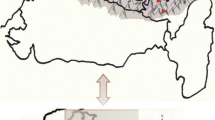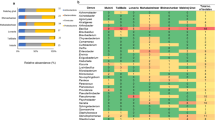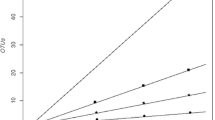Abstract
The aim of this study was to determine the bacterial diversity in soils of the southern region of the Western Ghats, a ‘biodiversity hotspot’, and thereby futher our understanding of the microbial communities in this ecological niche. The diversity and phylogeny of bacterial populations in soil samples collected from various locations of the Tamil Nadu and Kerala regions of Western Ghats were compared using both cultivation-dependent and cultivation-independent methods. A total of 171 bacterial strains were isolated based on their morphological characteristics and their diversity indices calculated. The distinctive amplified ribosomal DNA restriction analysis (ARDRA) pattern of each isolate was determined, and representative isolates were then subjected to 16S rRNA gene sequencing. On the basis of their sequence similarity, the isolates were distributed among three different genera belonging to Firmicutes (83.3 %), Proteobacteria (8.3 %) and high G+C Gram-positive bacteria (8.3 %). The highest and the lowest values for the diversity indices were obtained for metagenomic DNA extracted from isolates BWGA and BVP, respectively; these were used for 16S rRNA gene library construction and analysis. Based on their phylogenetic analysis, the predominant members of the habitat were found to belong to the phylum Firmicutes (84.62 %). Firmicutes was the dominant bacterial phylum detected by both approaches, but the culture-independent approach detected a considerably higher number of uncultivable bacteria. In conclusion, in our study of the bacterial diversity of this Western Ghats region, we fund that the genus Bacillus was predominant among the samples assessed by both cultivation-dependent and cultivation-independent methods.





Similar content being viewed by others
References
Ahmad N, Johri S, Abdin M, Qazi G (2009) Molecular characterization of bacterial population in the forest soil of Kashmir, India. World J Microbiol Biotechnol 25(1):107–113. doi:10.1007/s11274-008-9868-2
Amann RI (1995) In situ identification of microorganisms by whole cell hybridization with rRNA-targeted nucleic acid probes. In: Akkermans ADL, van Elsas JD, de Bruijn FJ (eds) Molecular microbial ecology manual. Kluwer Academic Publishers, Dordrecht
Amann RI, Ludwig W, Schleifer KH (1995a) Phylogenetic identification and in situ detection of individual microbial cells without cultivation. Microbiol Rev 59(1):143–169
Amann RI, Ludwig W, Schleifer KH (1995b) Phylogenetic identification and in situ detection of individual microbial cells without cultivation. Microbiol J Rev 59:143–169
Ausubel FM, Brent R, Kingston RE, Moore DD, Seidman JG, Smith JA, Struhl K (1987) Current protocols in molecular biology. John Wiley & Sons, New York
Bawa K, Joseph G, Setty S (2007) Poverty, biodiversity and institutions in forest-agriculture ecotones in the Western Ghats and Eastern Himalaya ranges of India. Agric Ecosyst Environ 121(3):287–295
Bianchi MAG, Armand JMB (1982) Statistical sampling of bacterial strains and its use in bacterial diversity measurement. Microb Ecol 8(1):61–69
Burmølle M, Johnsen K, Al-Soud WA, Hansen LH, Sørensen SJ (2009) The presence of embedded bacterial pure cultures in agar plates stimulate the culturability of soil bacteria. J Microbiol Meth 79(2):166–173. doi:10.1016/j.mimet.2009.08.006
Cho JC, Kim SJ (2000) Increase in bacterial community diversity in subsurface aquifers receiving livestock wastewater input. Appl Environ Microbiol 66(3):956–965. doi:10.1128/aem.66.3.956-965.2000
Dunbar J, Ticknor LO, Kuske CR (2000) Assessment of microbial diversity in four Southwestern United States soils by 16S rRNA gene terminal restriction fragment analysis. Appl Environ Microbiol 66(7):2943–2950. doi:10.1128/aem.66.7.2943-2950.2000
Felske ADM, Heyrman A, Balcaen A, de Vos P (2003) Multiplex PCR screening of soil isolates for novel Bacillus-related lineages. J Microbiol Meth 55:447–458
Hackl E, Zechmeister BS, Bodrossy L, Sessitsch A (2004) Comparison of diversities and compositions of bacterial populations inhabiting natural forest soils. Appl Environ Microbiol 70:5057–5065. doi:10.1128/AEM.70.9.5057-5065.2004
Hugenholtz P, Goebel BM, Pace NR (1998) Impact of culture-independent studies on the emerging phylogenetic view of bacterial diverity. J Bacteriol 180:4765–4774
Lane DJ, Pace B, Olsen GJ, Stahl DA, Sogin ML, Pace NR (1985) Rapid determination of 16S ribosomal RNA sequences for phylogenetic analyses. Proc Natl Acad Sci USA 82(20):6955–6959
McCaig AE, Glover LA, Prosser JI (1999) Molecular analysis of bacterial community structure and diversity in unimproved and improved upland grass pastures. Appl Environ Microbiol 65(4):1721–1730
McCaig AE, Grayston SJ, Prosser JI, Glover LA (2001) Impact of cultivation on characterisation of species composition of soil bacterial communities. FEMS Microbiol Ecol 35(1):37–48. doi:10.1111/j.1574-6941.2001.tb00786.x
Oline DK, Schmidt SK, Grant MC (2006) Biogeography and landscape-scale diversity of the dominant Crenarchaeota of soil. Microb Ecol 52:480–490
Oravecz O, Elhottová D, Krištůfek V, Šustr V, Frouz J, Tříska J, Márialigeti K (2004) Application of ARDRA and PLFA analysis in characterizing the bacterial communities of the food, gut and excrement of Saprophagous Larvae of Penthetria holosericea (Diptera: Bibionidae): a pilot study. Folia Microbiol 49(1):83–93. doi:10.1007/bf02931652
Pace NR (1997) A molecular view of microbial diversity and the biosphere. Science 276(5313):734–740. doi:10.1126/science.276.5313.734
Pignatelli M, Moya A, Tamames J (2009) EnvDB, a database for describing the environmental distribution of prokaryotic taxa. Environ Microbiol Rep 1(3):191–197. doi:10.1111/j.1758-2229.2009.00030.x
Raviraja NS (2005) Fungal endophytes in five medicinal plant species from Kudremukh range, Western Ghats of India. J Basic Microbiol 45(3):230–235. doi:10.1002/jobm.200410514
Ruckmani A, Chakrabarti T (2011) Analysis of bacterial community composition of a spring water from the Western Ghats, India using culture dependent and molecular approaches. Curr Microbiol 62(1):7–15. doi:10.1007/s00284-010-9663-9
Sambrook J, Fritsch EF, Maniatis T (1989) Molecular cloning. Cold Spring Harbor Laboratory Press, New York
Schallmey M, Singh A, Ward OP (2004) Developments in the use of Bacillus species for industrial production. Can J Microbiol 50:1–17
Schleifer KH (2004) Microbial diversity: facts, problems and prospects. Syst Appl Microbiol 27(1):3–9
Smit E, Leeflang P, Wernars K (1997) Detection of shifts in microbial community structure and diversity in soil caused by copper contamination using amplified ribozomal DNA restriction analysis. FEMS Microbiol Ecol 23:249–261
Tamura K, Peterso K, Peterson N, Stecher G, Masatoshi N, Sudhir K (2011) MEGA5: molecular evolutionary genetics analysis using maximum likelihood, evolutionary distance, and maximum parsimony methods. Mol Biol Evol 10(28):2731–2739
UNESCO (2012) http://whc.unesco.org/en/decisions/4280. Accessed 12 Apr 2014
Vaz-Moreira I, Egas C, Nunes O, Manaia C (2011) Culture-dependent and culture-independent diversity surveys target different bacteria: a case study in a freshwater sample. Antonie Van Leeuwenhoek 100(2):245–257. doi:10.1007/s10482-011-9583-0
Ward DM, Bateson MM, Weller R, Ruff-Roberts AL (1992) Ribosomal RNA analysis of microorganisms as they occur in nature. Adv Microb Ecol 12:219–286
Zhang C, Zhao X, Jing Y, Chida T, Chen H, Shen S (2008) Phenotypic and biological properties of two antagonist Bacillus subtilis strains. World J Microbiol Biotechnol 24(10):2179–2181. doi:10.1007/s11274-008-9723-5
Zhou J, Bruns M, Tiedge J (1996) DNA recovery from soils of diverse compositions. Appl Environ Microbiol 62:316–322
Acknowledgments
The study was supported by a grant from Department of Science and Technology (DST), India vide the grant SR/FT/LS-032/2008. V. Gowdaman gratefully acknowledges the University Research fellowship awarded to him by Bharathiar University.
Author information
Authors and Affiliations
Corresponding author
Electronic supplementary material
Below is the link to the Electronic Supplementary Material.
Supplementary Fig. 1
(DOCX 411 kb)
Supplementary Table 1
(DOCX 23 kb)
Supplementary Table 2
(DOCX 29 kb)
Supplementary Table 3
(DOCX 23 kb)
Rights and permissions
About this article
Cite this article
Vasudevan, G., Siddarthan, V. & Solai Ramatchandirane, P. Predominance of Bacillus sp. in soil samples of the southern regions of Western Ghats, India. Ann Microbiol 65, 431–441 (2015). https://doi.org/10.1007/s13213-014-0876-1
Received:
Accepted:
Published:
Issue Date:
DOI: https://doi.org/10.1007/s13213-014-0876-1




